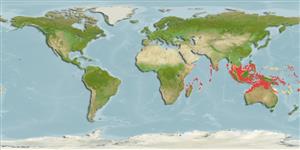Common names from other countries
>
Eupercaria/misc (Various families in series Eupercaria) >
Lethrinidae (Emperors or scavengers) > Lethrininae
Etymology: Lethrinus: Greek, lethrinia, a fish pertaining to genus Pagellus.
More on author: Smith.
Environment: milieu / climate zone / depth range / distribution range
Ecologia
marinhas associadas(os) a recifes; não migratória; intervalo de profundidade 5 - 220 m (Ref. 2295). Tropical; 14°N - 22°S
Indian Ocean: Tanzania, northern Madagascar, Chagos, Andamans and southwestern Indonesia.
Tamanho / Peso / Idade
Maturity: Lm ? range ? - ? cm
Max length : 76.0 cm TL macho/indeterminado; (Ref. 2295); common length : 50.0 cm TL macho/indeterminado; (Ref. 2295)
Espinhos dorsais (total) : 10; Raios dorsais (total) : 9; Espinhos anais: 3; Raios anais : 8.
Solitarily inhabits sand, rubble, and weed areas near corals (Ref. 90102) in deep reefs. Feeds on crustaceans and small fishes. Gonads in spawning state have been observed in October. This species is not well represented in museums due to the relatively large capture size for most specimens (Ref. 2295). Also caught with handlines (Ref. 9775).
Ciclo de vida ou comportamento de acasalamento
Maturities | Reprodução | Spawnings | Egg(s) | Fecundities | Larvas
Carpenter, K.E. and G.R. Allen, 1989. FAO Species Catalogue. Vol. 9. Emperor fishes and large-eye breams of the world (family Lethrinidae). An annotated and illustrated catalogue of lethrinid species known to date. FAO Fish. Synop. 125(9):118 p. Rome: FAO. (Ref. 2295)
Status na Lista Vermelha da UICN (Ref. 130435)
CITES (Ref. 128078)
Not Evaluated
Ameaça para os humanos
Harmless
Uso pelos humanos
Pescarias: espécies comerciais
Ferramentas
Relatórios especiais
Baixar XML
Fontes da internet
Estimates based on models
Preferred temperature (Ref.
115969): 23.2 - 28.3, mean 27 (based on 636 cells).
Índice de diversidade filogenética (Ref.
82804): PD
50 = 0.5000 [Uniqueness, from 0.5 = low to 2.0 = high].
Bayesian length-weight: a=0.01514 (0.00706 - 0.03245), b=2.98 (2.81 - 3.15), in cm Total Length, based on LWR estimates for this Genus-body shape (Ref.
93245).
Nível Trófico (Ref.
69278): 4.0 ±0.67 se; based on food items.
Resiliência (Ref.
120179): médio(a), tempo mínimo de duplicação da população 1,4 - 4,4 anos (Preliminary K or Fecundity.).
Fishing Vulnerability (Ref.
59153): Moderate to high vulnerability (50 of 100).
